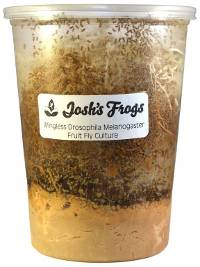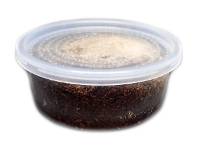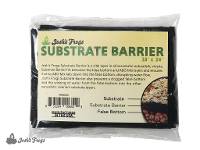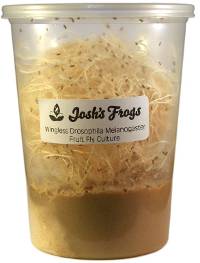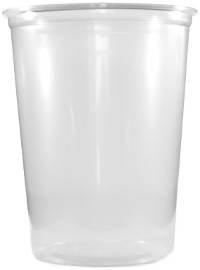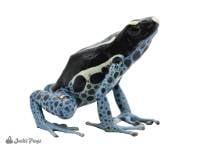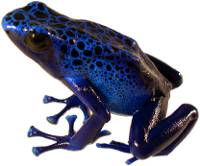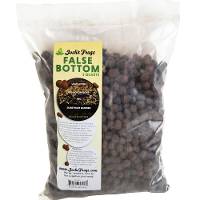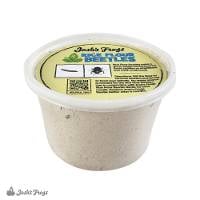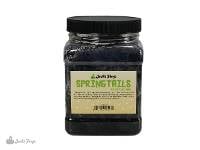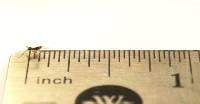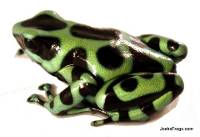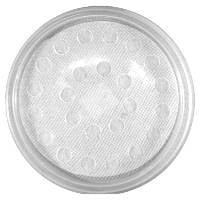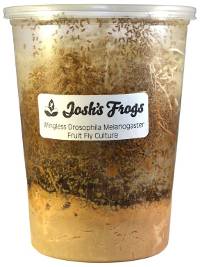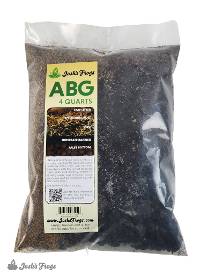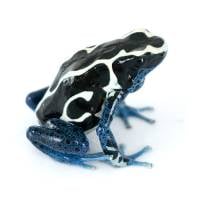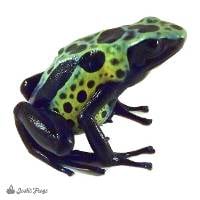Josh's Frogs
Why you should buy from us
Dendrobates tinctorius 'Bakhuis' (Captive Bred) - Dyeing Poison Arrow Frog
Dendrobates tinctorius 'Bakhuis' (Captive Bred) - Dyeing Poison Arrow Frog
$49.99 5.0 out of 5 stars
(29)
5.0 out of 5 stars
(29)About This Product
Defining Characteristics:
- Great beginner frog
- Contrasting yellow and black coloration
- Bold
- Easy to breed
- Quiet call
- Small
- Can be kept in groups when young
- Best kept in pairs as adults
Name: Dendrobates tinctorius 'Bakhuis'. Commonly called 'Bakhuis' in the US frog hobby, in Europe they are sometimes called Ensink tinctorius (due to Ensink bringing this morph to Holland, and introducing it into the trade. In the US, I've seen them incorrectly referred to as Ensing tinctorius.
Recommended Vivarium Size: A 10 gallon aquarium is suitable for a single or pair of Dendrobates tinctorius 'Bakhuis', but Josh's Frogs recommends a 20H or 18x18x18 Vivarium for 1-3 frogs. Not sure how to set up a vivarium? Please watch our video on How to Set Up a Vivarium.
Temperature: Dendrobates tinctorius 'Bakhuis' can tolerate a temperature range of 65 F to 80 F, but prefer temperatures in the low to mid 70s. Temperatures over 85F are dangerous.
Humidity: Like most poison dart frogs, Bakhuis prefer a humidity range of 70 – 100%, but can tolerate humidity down to 50% for short periods of time if the frogs have access to water. Low humidity levels, especially without access to water, can quickly be fatal.
Size: Adult female Bakhuis are larger, measuring in at approximately 1.25 inches. Male Bakhuis are a bit smaller, averaging about 1 inch at maturity. Bakhuis are a dwarf morph of tinctorius, and are quite a small tinc! All of the Dendrobates tinctorius 'Bakhuis' froglets Josh's Frogs sells are well started juveniles, and measure at least 5/8” long.
Age: Dendrobates tinctorius 'Bakhuis' is capable of living well over 20 years in captivity under ideal conditions, although a lifespan of 10 years is more common. In the wild, it is thought that Bakhuis may live 4-6 years. All Bakhuis for sale at Josh's Frogs are well started juveniles, and are 2-3 months old.
Feeding: Like most poison dart frogs, Bakhuis prefer smaller foods. All of the Bakhuis Josh's Frogs sells will readily eat Drosophila melanogaster fruit flies. Adult Dendrobates tinctorius 'Bakhuis' will readily consume Drosophila hydei fruit flies and pinhead crickets. All ages of poison dart frogs will enjoy springtails and isopods. All feeder insects should be dusted with a vitamin/mineral supplement. For more information on what poison dart frogs can eat, please visit our How-To Guide on Feeding Poison Dart Frogs.
Sexing: Dendrobates tinctorius 'Bakhuis' is not sexable until 10-12 months of age. Male Bakhuis tend to be smaller than females, which often appear both longer and wider. Males also tend to have wider front toe pads and a less defined back arch than females. Josh's Frogs sells 2-3 month old juveniles that are not sexable unless otherwise noted. For more information on sexing poison dart frogs, please visit our How-To Guide on Sexing Poison Dart Frogs.
Color/Pattern: A very variable poison dart frog, all Dendrobates tinctorius 'Bakhuis' appear mostly black with yellow dots and dashes. In some individuals, yellow lines are present. Older animals may take on a white and black appearance - this can be corrected by color enhancer supplementation. Josh's Frogs does not recommend, support, or endorse line breeding as we believe this leads to weaker captive animals and nature has done a wonderful job of creating an amazing variation in color and pattern of poison dart frogs already.
Social Behavior: Dendrobates tinctorius 'Bakhuis' do well housed in groups up to sexual maturity, as long as enough space is provided. Josh's Frogs recommends approximately 10 gallons per frog. As they reach sexual maturity at 10-12 months of age, the social dynamic in a group of Dendrobates tinctorius may change, and all but one female may need to be removed. Female D. tinctorius may fight with each other over a mate. For that reason, many breeders recommend keeping Bakhuis in pairs as adults. Bakhuis are a bit of an exception - given at least 10 gallons per frog, we've found keeping them in groups can work very well. Josh's Frogs strongly recommends against housing different species/morphs of dart frogs - for the health of your pets, please avoid mixing! Josh's Frogs recommends purchasing multiple frogs if you are interested in breeding them – this greatly increases the chances of getting a pair.
Breeding: Bakhuis are very simple and easy to breed. Like most Dendrobates tinctorius, Bakhuis are best bred in pairs as adult females may fight with each other in the presence of a male. Generally, eggs are deposited on a smooth broad leaf, or on a petri dish under a cocohut. The eggs hatch into tadpoles, which then take 60-80 days to complete metamorphosis into miniature versions of the adults. For more information on breeding and raising poison dart frogs, please visit our How-To Guide on Breeding Poison Dart Frogs.
Natural Range: Dendrobates tinctorius 'Bakhuis' is native to Suriname, where it occurs on Bakhuis mountain near Raleigh Falls.
History in the Hobby: Brought into Holland by Ensink, Bakhuis became established in Europe before being imported into the United States by Sean Stewart. A relatively new morph of tinctorius to the US hobby, they breed well and are widely available.
Links of Interest:
Tinctorius Morphguide, with great information on all morphs of Dendrobates tinctorius.
IUCN Redlist article on Dendrobates tinctorius.
Still not sure if Dendrobates tinctorius 'Bakhuis' from Josh's Frogs is the right poison dart frog for you? Read the reviews below and see what other customers are saying!
Shipping
After placing an order containing a live animal, you will receive a scheduling email containing our JotForm scheduling link to schedule your new pet's delivery date.
With this scheduling link, you will be able to schedule your order's delivery up to 30 days in advance. You will be able to choose a date of delivery for Tuesday-Saturday (Saturday arrival depends on the carrier's service availability) with the estimated time of arrival generally being 12pm, or 4:30pm for more rural areas. Overnight lows must be above 40°F to ship directly to you (or above 30°F for FedEx Ship Center pickups) as well as below 90°F by estimated time of arrival.
If you require further assistance, or prefer to talk to one of our Customer Service agents, please feel free to reach out to our [email protected] email or our phone line 1-800-691-8178.
Other Customers Also Bought
Customer Reviews
5.0 out of 5 stars
Based on 29 reviews
Review data
5 star reviews
- 100%
4 star reviews
- 0%
3 star reviews
- 0%
2 star reviews
- 0%
1 star reviews
- 0%
Reviews
Ally
5.0 out of 5 stars
Climber on my hands
He loves to climb which is entertaining.
Thomas Eric
5.0 out of 5 stars
Untitled
very nice frog, i have bought lots and lots and i do believe this is my favourite. though i had to wait because they were out of stock for so long, was worth the wait.
Alison
5.0 out of 5 stars
Nice color
He's so stinking cute
eric
5.0 out of 5 stars
awesome frogs
very new to dart frogs and just got my first two frogs in today and they are very active even when they been out of the box they were shipped in for about 3 hours now. one is hiding right now and one tries to escape the grow out tub when I open the container. they seem to be very healthy and I can't wait till they get big enough to be able to see the markings on them. would buy frogs from Josh's Frogs again. great packaging and they answer all and I mean all of my MANY questions
Skiser
5.0 out of 5 stars
Happy, Healthy, Bold, and Eating
Received this frog from Josh's Frogs last week, and it has acclimated perfectly in its new home. Arrived healthy and in great condition, and was eating regularly within the first few days of being in the new vivarium. It is a very cool looking frog, and even though it is still a juvenile, it comes right to the front of the tank at feeding time.
Showing 1 to 5 of 29 results


